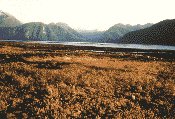| Feature Type: | Community - An unincorporated populated place, generally with a population of 50 or more, and having a recognized central area that might contain a post office, store and/or community hall, etc, intended for the use of the general public in the region. |
| Status: | Not official |
| Other Names: | GingolxOfficial |
| Relative Location: | N side of Nass Bay at the mouth of Nass River, Range 5 Coast Land District |
| Latitude-Longitude: | 54°59'39"N, 129°57'21"W at the approximate population centre of this feature. |
| Datum: | WGS84 |
| NTS Map: | 103I/13 |

|
Origin Notes and History:
|
Kincolith Mission is labelled on British Admiralty Chart A2190, 1868. Kincolith (Post Office & Indian Village) adopted in the 1930 BC Gazetteer. Form of name changed to Kincolith (Post Office) 4 November 1948 on 103NE; confirmed 4 October 1951 on 103I. Form of name changed to Kincolith (Post Office & Steamer Landing) for the 1953 Gazetteer; further changed to Kincolith (Community) 14 January 1983 on 103I/13. Spelling changed to Gingolx (Community) per Nisga'a Treaty, Appendix F-3, effective 11 May 2000. Source: BC place name cards, or correspondence to/from BC's Chief Geographer or BC Geographical Names Office |
|
This name was given to the place by the Indians because a notorious Tsimpsian chief, named High-mahsh, after returning from his raids on neighbouring tribes, nailed up the scalps of his victims on the trees in the ravine. The name Kincolith means "place of scalps". Reverend Robert Tomlinson established a mission village here in 1867. Source: Walbran, John T; British Columbia Coast Names, 1592-1906: their origin and history; Ottawa, 1909 (republished for the Vancouver Public Library by J.J. Douglas Ltd, Vancouver, 1971) |
|
This village at the mouth of the Nass River was founded by Christian Nisgha (sic) in the last century. In pre-contact times the site was not settled, but people came here seasonally to gather shellfish and crabs. Because of its' importance as a food source and its' location at the mouth of the oolichan-rich Nass River, the place was at times contested between the various peoples of the area (Tsimshian, Haida, Nisgha), and violent incidents often took place. One of them, which may or may not have involved the Tsimshian chief Haymaas, is commemorated in the Nisgha name Gingolx ("place of the skulls") from "gin" meaning "place of" and "golx" meaning "skull" (M-L Tarpent, NW Languages Newsletter, Vol 4, No 2, p.4). Source: BC place name cards, or correspondence to/from BC's Chief Geographer or BC Geographical Names Office |
|
A Haida expedition had been raiding up the Nass River and as it approached the open sea on their homeward journey, some of the prisoners struggled so hard to get free that the Haidas, fearing their canoes would upset, landed at this point and killed all who were resisting. The heads of the victims were left displayed on the bluff here, thus giving rise to the name Kincolith, "the place of the skulls" (sometimes "place of scalps"). Source: Akrigg, Helen B. and Akrigg, G.P.V; British Columbia Place Names; Sono Nis Press, Victoria 1986 /or University of British Columbia Press 1997 |
|
In 1867, Rev. R. Doolan, along with a raft of Nisga'a converts, left the village of Abanseeks to establish a mission at Xmaat'in (Dogfish Bight). In a futile attempt to cross Saxwhl Xk'alaan (the mouth (?) of Portland Inlet, they beached at Ksi Gingolx and established here instead. Hence it became known as the Christian village of Kincolith. Source: Nisga'a Tribal Council / Ayuukhl Nisga'a Department, Aiyansh BC |
|
"Kincolith" is the anglicized [spelling] for the Nisga'a name, Gingolx, so named after an historic battle between the Nisga'a and the Haida, and following which the scalps of the defeated Haida were hung on poles and erected at this site on a rock bluff. This practice was carried out as a warning to any further raids. [Gin/ to feed, present, it could also mean 'place of'; golx/ scalp]. This site was originally the clan resource territory of the Gisk'aast, but was later turned over to the village for sustenance. And it was because of its importance as a food source - shellfish, salmon, etc - and its location at the mouth of the oolichan-rich Nass River that the Nisga'a were at times raided by other tribes in the surrounding area - the Tsimshian, Haida, and Tlingit. Source: Nisga'a Tribal Council / Ayuukhl Nisga'a Department, Aiyansh BC |
|
The Gingolx territory is so named following a historic battle between the Nisga'a and Ha'idax (Haida), after which time the Haida scalps/golx were hung on poles and set adrift in a canoe. The scalps were presented/gin (derived from ginam, 'to give') in such a fashion to warn or provoke the enemy, "We're ready, if you want to fight!". Prior to this war with the Haida, the name of this place was Wil Luugigyookshl Lo'op (advice from Nisga'a elder Geoffrey C. Benson, 1975) Source: Nisga'a Tribal Council / Ayuukhl Nisga'a Department, Aiyansh BC |

